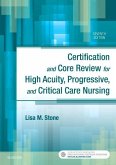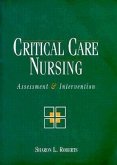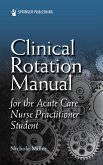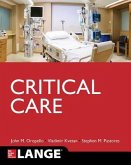- Broschiertes Buch
- Merkliste
- Auf die Merkliste
- Bewerten Bewerten
- Teilen
- Produkt teilen
- Produkterinnerung
- Produkterinnerung
Preceded by AACN advanced critical care nursing / [edited by] Karen K. Carlson. 2009.
Andere Kunden interessierten sich auch für
![Certification and Core Review for High Acuity, Progressive, and Critical Care Nursing Certification and Core Review for High Acuity, Progressive, and Critical Care Nursing]() Lisa M StoneCertification and Core Review for High Acuity, Progressive, and Critical Care Nursing78,99 €
Lisa M StoneCertification and Core Review for High Acuity, Progressive, and Critical Care Nursing78,99 €![A Nurse's Survival Guide to Critical Care - Updated Edition A Nurse's Survival Guide to Critical Care - Updated Edition]() Sharon L EdwardsA Nurse's Survival Guide to Critical Care - Updated Edition45,99 €
Sharon L EdwardsA Nurse's Survival Guide to Critical Care - Updated Edition45,99 €![Critical Care Nursing: Assessment and Intervention Critical Care Nursing: Assessment and Intervention]() Sharon L. RobertsCritical Care Nursing: Assessment and Intervention60,99 €
Sharon L. RobertsCritical Care Nursing: Assessment and Intervention60,99 €![Critical Care Critical Care]() Theresa BrownCritical Care19,99 €
Theresa BrownCritical Care19,99 €![Clinical Rotation Manual for the Acute Care Nurse Practitioner Student Clinical Rotation Manual for the Acute Care Nurse Practitioner Student]() Nichole MillerClinical Rotation Manual for the Acute Care Nurse Practitioner Student46,99 €
Nichole MillerClinical Rotation Manual for the Acute Care Nurse Practitioner Student46,99 €![Lange Critical Care Lange Critical Care]() John M OropelloLange Critical Care159,99 €
John M OropelloLange Critical Care159,99 €![Nursing Management of the Neurosurgical Patient: An Interprofessional Approach Nursing Management of the Neurosurgical Patient: An Interprofessional Approach]() Nursing Management of the Neurosurgical Patient: An Interprofessional Approach73,99 €
Nursing Management of the Neurosurgical Patient: An Interprofessional Approach73,99 €-
-
-
Preceded by AACN advanced critical care nursing / [edited by] Karen K. Carlson. 2009.
Hinweis: Dieser Artikel kann nur an eine deutsche Lieferadresse ausgeliefert werden.
Hinweis: Dieser Artikel kann nur an eine deutsche Lieferadresse ausgeliefert werden.
Produktdetails
- Produktdetails
- Verlag: Elsevier Health Sciences
- 2nd edition
- Seitenzahl: 912
- Erscheinungstermin: 22. Februar 2017
- Englisch
- Abmessung: 274mm x 216mm x 28mm
- Gewicht: 1678g
- ISBN-13: 9781455758753
- ISBN-10: 1455758752
- Artikelnr.: 47791066
- Herstellerkennzeichnung
- Libri GmbH
- Europaallee 1
- 36244 Bad Hersfeld
- gpsr@libri.de
- Verlag: Elsevier Health Sciences
- 2nd edition
- Seitenzahl: 912
- Erscheinungstermin: 22. Februar 2017
- Englisch
- Abmessung: 274mm x 216mm x 28mm
- Gewicht: 1678g
- ISBN-13: 9781455758753
- ISBN-10: 1455758752
- Artikelnr.: 47791066
- Herstellerkennzeichnung
- Libri GmbH
- Europaallee 1
- 36244 Bad Hersfeld
- gpsr@libri.de
UNIT I: INTRODUCTION
1. The Evolving Critical Care Environment
UNIT II: CARDIAC
2. Advanced Dysrhythmias
3. Acute Coronary Syndromes
4. Heart Failure
5. Cardiac Surgery
6. Valvular Disease and Surgery
7. Vascular Emergencies
8. Heart and Lung Transplantation
UNIT III: PULMONARY
9. Acute Respiratory Failure and Acute Lung Injury
10. Mechanical Ventilation and Weaning
11. Thoracic Surgery
UNIT IV: NEUROLOGIC
12. Head Injury and Dysfunction
13. Cerebrovascular Disorders
14. Spinal Cord Injury
15. Special Neurologic Patient Populations
UNIT V: GASTROINTESTINAL
16. Gastrointestinal Bleeding
17. Liver Dysfunction and Failure
18. Pancreatitis
19. The Gut in Critical Illness
20. Liver, Kidney, and/or Pancreas Transplantation
UNIT VI: RENAL
21. Electrolyte Emergencies
22. Complex Acid-Base Disorders and Associated Electrolyte Imbalances
23. Acute Renal Failure
UNIT VII: ENDOCRINE
24. Glycemic Control
25. Pituitary, Thyroid, and Adrenal Disorders
UNIT VIII: HEMATOLOGIC
26. Blood Conservation / Blood Component Replacement
27. Coagulopathies
UNIT IX: MULTISYSTEM
28. Shock and End Points of Resuscitation
29. Optimizing Hemodynamics: Strategies for Fluid and Medication Titration
in Shock
30. Trauma and Mass-Casualty Competencies
31. Systemic Inflammatory Response Syndrome and Multiple Organ Dysfunction
Syndrome
UNIT X: SPECIAL PATIENT POPULATIONS
32. Caring for the Immunocompromised Patient
33. Caring for the Patient in the Immediate Postoperative Period
34. Caring for the Critically Ill Pregnant Patient
35. Caring for the Pediatric Patient in an Adult Critical Care Unit
36. Caring for the Critically Ill Elderly Patient
37. Caring for the Critically Ill Patient with a Neuropsychiatric Disorder
38. Caring for the Bariatric Patient
UNIT XI: SPECIAL CONSIDERATIONS IN CRITICAL CARE
39. Pain and Sedation
40. Comorbid Conditions
41. Oncologic Emergencies
42. Chemical Dependency
43. End-of-Life Care
Appendix A: Answers to Decision Point Questions
1. The Evolving Critical Care Environment
UNIT II: CARDIAC
2. Advanced Dysrhythmias
3. Acute Coronary Syndromes
4. Heart Failure
5. Cardiac Surgery
6. Valvular Disease and Surgery
7. Vascular Emergencies
8. Heart and Lung Transplantation
UNIT III: PULMONARY
9. Acute Respiratory Failure and Acute Lung Injury
10. Mechanical Ventilation and Weaning
11. Thoracic Surgery
UNIT IV: NEUROLOGIC
12. Head Injury and Dysfunction
13. Cerebrovascular Disorders
14. Spinal Cord Injury
15. Special Neurologic Patient Populations
UNIT V: GASTROINTESTINAL
16. Gastrointestinal Bleeding
17. Liver Dysfunction and Failure
18. Pancreatitis
19. The Gut in Critical Illness
20. Liver, Kidney, and/or Pancreas Transplantation
UNIT VI: RENAL
21. Electrolyte Emergencies
22. Complex Acid-Base Disorders and Associated Electrolyte Imbalances
23. Acute Renal Failure
UNIT VII: ENDOCRINE
24. Glycemic Control
25. Pituitary, Thyroid, and Adrenal Disorders
UNIT VIII: HEMATOLOGIC
26. Blood Conservation / Blood Component Replacement
27. Coagulopathies
UNIT IX: MULTISYSTEM
28. Shock and End Points of Resuscitation
29. Optimizing Hemodynamics: Strategies for Fluid and Medication Titration
in Shock
30. Trauma and Mass-Casualty Competencies
31. Systemic Inflammatory Response Syndrome and Multiple Organ Dysfunction
Syndrome
UNIT X: SPECIAL PATIENT POPULATIONS
32. Caring for the Immunocompromised Patient
33. Caring for the Patient in the Immediate Postoperative Period
34. Caring for the Critically Ill Pregnant Patient
35. Caring for the Pediatric Patient in an Adult Critical Care Unit
36. Caring for the Critically Ill Elderly Patient
37. Caring for the Critically Ill Patient with a Neuropsychiatric Disorder
38. Caring for the Bariatric Patient
UNIT XI: SPECIAL CONSIDERATIONS IN CRITICAL CARE
39. Pain and Sedation
40. Comorbid Conditions
41. Oncologic Emergencies
42. Chemical Dependency
43. End-of-Life Care
Appendix A: Answers to Decision Point Questions
UNIT I: INTRODUCTION
1. The Evolving Critical Care Environment
UNIT II: CARDIAC
2. Advanced Dysrhythmias
3. Acute Coronary Syndromes
4. Heart Failure
5. Cardiac Surgery
6. Valvular Disease and Surgery
7. Vascular Emergencies
8. Heart and Lung Transplantation
UNIT III: PULMONARY
9. Acute Respiratory Failure and Acute Lung Injury
10. Mechanical Ventilation and Weaning
11. Thoracic Surgery
UNIT IV: NEUROLOGIC
12. Head Injury and Dysfunction
13. Cerebrovascular Disorders
14. Spinal Cord Injury
15. Special Neurologic Patient Populations
UNIT V: GASTROINTESTINAL
16. Gastrointestinal Bleeding
17. Liver Dysfunction and Failure
18. Pancreatitis
19. The Gut in Critical Illness
20. Liver, Kidney, and/or Pancreas Transplantation
UNIT VI: RENAL
21. Electrolyte Emergencies
22. Complex Acid-Base Disorders and Associated Electrolyte Imbalances
23. Acute Renal Failure
UNIT VII: ENDOCRINE
24. Glycemic Control
25. Pituitary, Thyroid, and Adrenal Disorders
UNIT VIII: HEMATOLOGIC
26. Blood Conservation / Blood Component Replacement
27. Coagulopathies
UNIT IX: MULTISYSTEM
28. Shock and End Points of Resuscitation
29. Optimizing Hemodynamics: Strategies for Fluid and Medication Titration
in Shock
30. Trauma and Mass-Casualty Competencies
31. Systemic Inflammatory Response Syndrome and Multiple Organ Dysfunction
Syndrome
UNIT X: SPECIAL PATIENT POPULATIONS
32. Caring for the Immunocompromised Patient
33. Caring for the Patient in the Immediate Postoperative Period
34. Caring for the Critically Ill Pregnant Patient
35. Caring for the Pediatric Patient in an Adult Critical Care Unit
36. Caring for the Critically Ill Elderly Patient
37. Caring for the Critically Ill Patient with a Neuropsychiatric Disorder
38. Caring for the Bariatric Patient
UNIT XI: SPECIAL CONSIDERATIONS IN CRITICAL CARE
39. Pain and Sedation
40. Comorbid Conditions
41. Oncologic Emergencies
42. Chemical Dependency
43. End-of-Life Care
Appendix A: Answers to Decision Point Questions
1. The Evolving Critical Care Environment
UNIT II: CARDIAC
2. Advanced Dysrhythmias
3. Acute Coronary Syndromes
4. Heart Failure
5. Cardiac Surgery
6. Valvular Disease and Surgery
7. Vascular Emergencies
8. Heart and Lung Transplantation
UNIT III: PULMONARY
9. Acute Respiratory Failure and Acute Lung Injury
10. Mechanical Ventilation and Weaning
11. Thoracic Surgery
UNIT IV: NEUROLOGIC
12. Head Injury and Dysfunction
13. Cerebrovascular Disorders
14. Spinal Cord Injury
15. Special Neurologic Patient Populations
UNIT V: GASTROINTESTINAL
16. Gastrointestinal Bleeding
17. Liver Dysfunction and Failure
18. Pancreatitis
19. The Gut in Critical Illness
20. Liver, Kidney, and/or Pancreas Transplantation
UNIT VI: RENAL
21. Electrolyte Emergencies
22. Complex Acid-Base Disorders and Associated Electrolyte Imbalances
23. Acute Renal Failure
UNIT VII: ENDOCRINE
24. Glycemic Control
25. Pituitary, Thyroid, and Adrenal Disorders
UNIT VIII: HEMATOLOGIC
26. Blood Conservation / Blood Component Replacement
27. Coagulopathies
UNIT IX: MULTISYSTEM
28. Shock and End Points of Resuscitation
29. Optimizing Hemodynamics: Strategies for Fluid and Medication Titration
in Shock
30. Trauma and Mass-Casualty Competencies
31. Systemic Inflammatory Response Syndrome and Multiple Organ Dysfunction
Syndrome
UNIT X: SPECIAL PATIENT POPULATIONS
32. Caring for the Immunocompromised Patient
33. Caring for the Patient in the Immediate Postoperative Period
34. Caring for the Critically Ill Pregnant Patient
35. Caring for the Pediatric Patient in an Adult Critical Care Unit
36. Caring for the Critically Ill Elderly Patient
37. Caring for the Critically Ill Patient with a Neuropsychiatric Disorder
38. Caring for the Bariatric Patient
UNIT XI: SPECIAL CONSIDERATIONS IN CRITICAL CARE
39. Pain and Sedation
40. Comorbid Conditions
41. Oncologic Emergencies
42. Chemical Dependency
43. End-of-Life Care
Appendix A: Answers to Decision Point Questions








